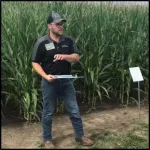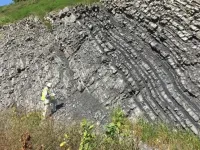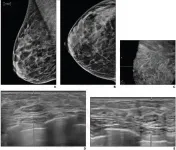University of Minnesota develops new tool to help farmers make crop input decisions
Understanding the cost and social benefits of using less nitrogen across the US corn belt
2021-07-15
(Press-News.org) Reducing greenhouse gas emissions (GHGs) and nitrogen water pollution from agriculture are top environmental priorities in the United States. Key to achieving climate goals is helping producers navigate carbon markets, while also helping the environment and improving farm income.
A new tool developed by a University of Minnesota research team allows farmers to create a budget balance sheet of any nitrogen reduction plans and see the economic and environmental cost, return and margins, all customized to fields under their management.
"With these numbers in mind, farmers can make more informed decisions on nitrogen mitigation that not only saves them money, but also significantly reduces pollutants to the environment," said Zhenong Jin, who led the research and is an assistant professor in the Department of Bioproducts and Biosystems Engineering (BBE) in the College of Food, Agricultural and Natural Resource Sciences (CFANS).
Previous tools did not allow for customized predictions for every field in the U.S. corn belt, as the computational and storage costs of running these crop models at large scale would be very expensive.
As outlined in an article published in IOPscience, the research team built a series of machine-learning-based metamodels that can almost perfectly mimic a well-tested crop model at much faster speeds. Using the metamodels, they generated millions of scenario simulations and investigated two fundamental sustainability questions -- where are the mitigation hotspots, and how much mitigation can be expected under different management scenarios.
"We synthesized four simulated indicators of agroecosystem sustainability -- yield, N2O emissions, nitrogen leaching, and changes in soil organic carbon -- into economic net societal benefits as the basis for identifying hotspots and infeasible land for mitigation," said Taegon Kim, CFANS research associate in the BBE department. The societal benefits include cost savings from GHG mitigation, as well as improved water and air quality.
"By providing key sustainability indicators related to upstream crop production, our metamodels can be a useful tool for food companies to quantify the emissions in their supply chain and distinguish mitigation options for setting sustainability goals," said Timothy Smith, professor of Sustainable Systems Management and International Business Management in CFANS's BBE department.
The study, conducted in the U.S. Midwest corn belt, found that:
Reducing nitrogen fertilizer by 10% leads to 9.8% less N2O emissions and 9.6% less nitrogen leaching, at the cost of 4.9% more soil organic carbon depletion, but only a 0.6% yield reduction over the study region.
The estimated net total annual social benefits are worth $395 million (uncertainty ranges from $114 million to nearly $1.3 billion), including a savings of $334 million by avoiding GHG emissions and water pollution, $100 million using less fertilizer, and a negative $40 million due to yield losses.
More than 50% of the net social benefits come from 20% of the study areas, thus can be viewed as hot spots where actions should be prioritized.
"Our analysis revealed hot spots where excessive nitrogen fertilizer can be cut without yield penalty," said Jin. "We noticed in some places that reducing nitrogen-related pollution comes at a cost of depleting organic carbon in soil, suggesting that other regenerative practices, such as cover cropping, need to be bundled with nitrogen management."
In the future, the team will expand the framework presented in this study and develop more advanced and accurate carbon qualification models through a combination of process-based models, artificial intelligence and remote sensing.
INFORMATION:
This research was funded by the University of Minnesota AGREETT program, the National Science Foundation and the U.S. Department of Energy Advanced Research Projects Agency-Energy (ARPA-E).
ELSE PRESS RELEASES FROM THIS DATE:
2021-07-15
(LOS ANGELES) - Many bodily functions in humans are manifested by mechanical deformations to the skin - from the stretching, bending and movement of muscles and joints to the flutter of a pulse at the wrist. These mechanical changes can be detected and monitored by measuring different levels of strain at various points throughout the body.
In recent years, much attention has been focused on wearable sensors to measure these strains for use in personal health monitoring. Some of these sensors can detect high-level (40-100%) strains, such as those associated with the movements of fingers ...
2021-07-15
A new protein-based vaccine candidate combined with a potent adjuvant provided effective protection against SARS-CoV-2 when tested in animals, suggesting that the combination could add one more promising COVID-19 vaccine to the list of candidates for human use. The protein antigen, based on the receptor binding domain (RBD) of SARS-CoV-2, was expressed in yeast instead of mammalian cells - which the authors say could enable a scalable, temperature-stable, low-cost production process well suited for deployment in the developing world. In a study by Maria Pino and colleagues, the adjuvant ...
2021-07-15
Concern has grown about prison systems' use of extended solitary confinement as a way to manage violent and disruptive incarcerated people. A new study identified groups that are more likely to be placed in extended solitary management (ESM). The study found that individuals sent to ESM differed considerably from the rest of the prison population in terms of mental health, education, language, race/ethnicity, and age.
The study, by researchers at Florida State University and the University of Cincinnati, appears in Justice Quarterly, a publication of the Academy of Criminal Justice Sciences.
"Many ...
2021-07-15
URBANA, Ill. - Corn growers can choose from a wide array of products to make the most of their crop, but the latest could bring seaweed extract to a field near you. The marine product is just one class in a growing market of crop biostimulants marketed for corn.
Biostimulants benefit crops and soil, but the dizzying array of products has farmers confused, according to Fred Below, corn and soybean researcher at the University of Illinois.
"Farmers hear the term 'plant biostimulant' and think they all do the same thing, and can be used in the same way at the same time. But that's not the case. There's huge confusion ...
2021-07-15
Earth's climate was relatively stable for a long period of time. For three billion years, temperatures were mostly warm and carbon dioxide levels high - until a shift occurred about 400 million years ago. A new study suggests that the change at this time was accompanied by a fundamental alteration to the carbon-silicon cycle. "This transformation of what was a consistent status quo in the Precambrian era into the more unstable climate we see today was likely due to the emergence and spread of new life forms," said Professor Philip Pogge von Strandmann, a geoscientist at Johannes ...
2021-07-15
Burnout. It is a syndrome that is said to afflict humans who feel chronic stress. But after conducting a novel study using trail cameras showing the interactions between white-tailed deer fawns and predators, a Penn State researcher suggests that prey animals feel it, too.
"And you can understand why they do," said Asia Murphy, who recently graduated with a doctorate from Penn State's Intercollege Graduate Degree Program in Ecology. "Less than half of whitetail fawns live to see their first birthday, and many are killed by predators, such as coyotes, black ...
2021-07-15
Researchers from Skoltech have found a way to help computer vision algorithms process satellite images of the Earth more accurately even with very limited data for training. This will make various remote sensing tasks easier for machines and ultimately the people who use their data. The paper outlining the new results was published in the journal Remote Sensing.
Researchers have been using computer vision and machine learning techniques to help with environmental monitoring for a while now. Tasks that may seem tedious and prone to human error are normally a piece of cake for algorithms. But before a neural network can successfully, say, discriminate between the kinds of trees in a forested area, it needs to be trained, ...
2021-07-15
WHAT:
Among 6- and 7-year-olds who were born extremely preterm--before the 28th week of pregnancy--those who had more than two hours of screen time a day were more likely to have deficits in overall IQ, executive functioning (problem solving skills), impulse control and attention, according to a study funded by the National Institutes of Health. Similarly, those who had a television or computer in their bedrooms were more likely to have problems with impulse control and paying attention. The findings suggest that high amounts of screen time may ...
2021-07-15
Leesburg, VA, July 15, 2021--According to ARRS' American Journal of Roentgenology (AJR), return to routine screening for BI-RADS 3 lesions on supplemental automated whole-breast US (ABUS) substantially reduces the recall rate, while being unlikely to result in adverse outcome.
"This prospective study supports a recommendation for routine annual follow-up for BI-RADS 3 lesions at supplemental ABUS," wrote lead author Richard G. Barr of Northeastern Ohio Medical University in Rootstown.
From August 2013 to December 2016, Barr and colleagues' prospective study (NCT02650778) ...
2021-07-15
Undeniably the shark movie to end all shark movies, the 1975 blockbuster, Jaws, not only smashed box office expectations, but forever changed the way we felt about going into the water - and how we think about sharks.
Now, more than 40 years (and 100+ shark movies) on, people's fear of sharks persists, with researchers at the University of South Australia concerned about the negative impact that shark movies are having on conservation efforts of this often-endangered animal.
In a world-first study, conservation psychology researchers, UniSA's Dr Briana Le Busque and Associate Professor Carla Litchfield ...
LAST 30 PRESS RELEASES:
[Press-News.org] University of Minnesota develops new tool to help farmers make crop input decisions
Understanding the cost and social benefits of using less nitrogen across the US corn belt



